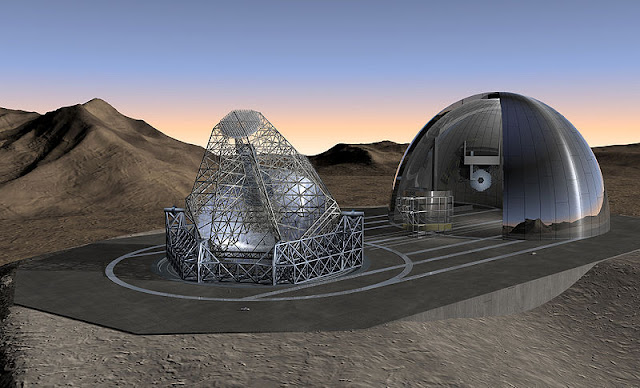Any discussion about telescopes MUST begin with the amazing astronmer William Herschel.
William Hershel built over 400 telescopes in his lifetime. With these telescopes, he discovered the new planet Uranus along with the moons Mimas, Enceladus, Titania, and Oberon. He also discovered that the sun gave off an invisible form of heat know as infrared radiation. His work during the late 1700s and early 1800s set the stage for many more larger telescopes in the centuries to come.
This is Herschel's largest telescope. Imagine this in your backyard! Notice it had wheels and a track. Why was this important? This telescope was so large that the astronomer sat in a small house during viewing.
This the HET telescope in far west Texas. It is the 4th largest optical telescope in the world. One of the planned uses for this telescope will be a project on discovering Dark Matter.
Here's the HET at night. The McDonald Observatory has 5 large telescopes next to each other. They have tours open to the public. It's a long drive, but maybe someday you'll go there.
This is the largest Radio Telescope in the world in Arecibo, Puerto Rico.
You can probably guess the name of this telescope. Did you say Hubble?
The European Southern Observatory contains a set of 4 massive telescopes in the remote Atacama Desert in Chile. These are some of the most powerful in the world. Two of them are shown here. Do you know what's shown in the sky behind them?
Why so many telescopes? Well, as you can see in this set of images, different types of telescopes bring us different types of information. Which image do you like the most?
THE FUTURE OF TELESCOPES
The E-ELT (European Extremely Large Telescope) is planned for 2022. It will be 1,500 times stronger than Hubble. The mirrors will be 128 FEET across. Currently, a very large telescope is 128 inches across!
Finally, this is the OWL or OverWhelmingly Large Telescope. It is proposed to be 300 feet in diameter. We don't have the technology to build it...yet. Maybe you will!
Applying what you've learned. Answer the question below:
The VLA or Very Large Array in Socorro, New Mexico are
A. optical telescopes
B. radio telescopes
C. a space telescope
D. a new kind of dish TV
QUESTION 2:
Which of these is on the electromagnetic spectrum?
A. infraviolet
B. y-rays
C. ultrared
D. radio waves
QUESTION 3:
Pick the space telescope's correct name:
A. Hubba-Bubba
B. Hubble
C. Hoover
D. Houston, we have a problem?











No comments:
Post a Comment
Thanks for stopping by our classroom website and leaving positive comments! Mr. Petersen :-)